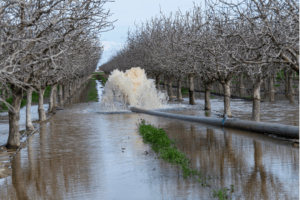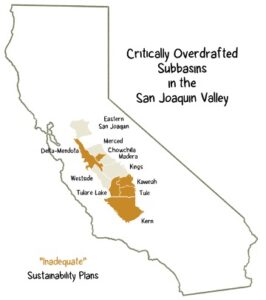Susie Cagle
- 2023

Fellowship Title:
- The Unintended Consequences of California’s Water Policies
Fellowship Year:
- 2023
How Government and Private Firms Shaped California’s Devastating Floods
In a land gripped by its history of drought, the Central Valley has planned poorly for its floods, threatening the lives and livelihoods of thousands. A few days after the flooding in California’s Central Valley began in March, George Wurzel, the president and chief operating officer of JG Boswell Company, took the podium at an emergency Kings County board of supervisors meeting, already on the defensive. The Boswell Company was no stranger to floods – the founding Boswell had derived his fortune from claiming and draining much of the Tulare lake bottom that had once been the largest body of fresh water west of the Mississippi, and the lake was known for returning periodically despite the firm’s best efforts.A remarkable but not unexpected combination of events had forced the issue: For the first time in precisely 40 years, the lake was pressing up against the too-low levee protecting the town of Corcoran, along with the largest concentration of incarcerated people in the state at two large prisons. The Boswell Company, with its large landholdings, was

Historic Wet Year Highlights California’s Water Management Crossroads
Barriers to capturing and storing flood water may threaten the Golden State’s ability to adapt to a hotter, drier climate. Not so long ago, the dry western expanse of Madera County in California’s San Joaquin Valley was a prime example of shortsighted western water management. New nut orchards stretched for miles and dozens of deep wells drove into the deep clay to reach the lower ancient aquifer in the Red Top region. So much groundwater was pumped out that the soil compressed, sinking the ground several inches a year, tipping canals and sending the water running backwards. Ten years and a package of groundwater management laws later, the Red Top area is working to become a model for redemption. Groundwater recharge projects have offset enough of the aquifer pumping that area growers have raised their pumps, now only drawing on the upper recharged aquifer instead of puncturing the lower clay. Subsidence, the caving in of the earth, has subsided. Sarah Woolf, who manages the Triangle T Water District recharge project in Red Top that pulls

California’s Dual Water Crisis
Record-breaking storms are wreaking havoc – compounding, not erasing, the difficulties of multi-year drought. The renter’s home in Sanger, just outside Fresno, went dry in the spring. The well at one house in Madera has been on and off since January 2021. The homeowners in Dinuba can’t figure out why the water keeps getting lower, further out of reach. Meanwhile, the rainstorms keep coming. While the contours of drought recede on the official California map, residential wells across its gutted Central Valley continue to run dry. California Department of Water Resources (DWR) well records paint a picture of a state in the midst of a climate-driven water crisis that seems absurd if not tragic on its face – too much and too little all at once, even in the same place. One homeowner reached out to their local state representative for help – could they bring a pump to move some of those floodwaters down to their dry well? “I thought, wow, good for you for your creativity. I don’t think that’s going to work.
